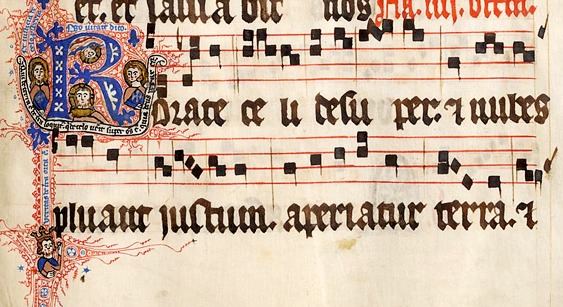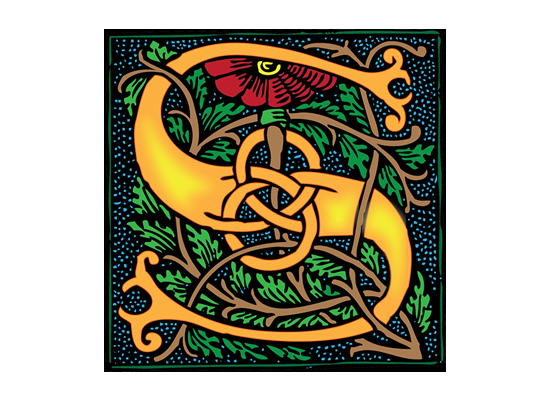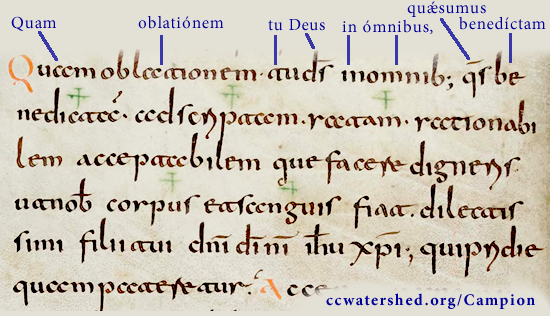After a recent article singing Vespers for the US war veterans in Manchester, New Hampshire, people have been asking me where they can get hold of the music. In response to this I have put all the tones we have on a newly published page on my blog, here.
Before I describe what you will find there, I would just like to describe the last time we went to the veteran's hospitial in Manchester, NH. We arrived as usual and were greeted by Fr Boucher in the chapel. Nobody else was there. Fr Boucher thanked us warmly for coming and told us that several veterans had wanted to come but were too ill to go from ward to chapel, and two had died earlier that day. Fr Boucher wanted us to know how important therefore, our prayer was and how much appreciated even by those who can't attend. So we sang Vespers and Compline just as intended and as beautifully as we could for those who could not hear us.
We are grateful to him and also to the other chaplains, including the Chief Chaplain (who is not Catholic) for their support, he wrote to me: "My role is tiny as one of the Catholic chaplains, but I attend every one of these 'lay-led' services. Our Chief Chaplain, Gary Rolph, has been extremely supportive, along with his wife, who attend the Monday evening service whenever they can. Father Tom Steinmetz, of the Melkite Catholic Community is the regularly assigned catholic priest. Both he and I are appreciative of the charity of this Monday night chorus of praise to the Lord on behalf of those who are at chapel or lodge nearby with the knowledge that we pray for their care and sing in their stead. ---Father Roger Boucher, US Navy, retired."
The psalm tones we use are modal and the starting point is the natural rhythm of speech. They conform to the pattern of language, rather than imposing their own rhythm on the words. This means that once you understand how the system works, which is pretty simple, they flow naturally and it frees you to contemplate the text more deeply.
These tones are arranged so that any tone can be applied to any text and they always follow the natural rhythm of the words of the text. The system is so simple, that you don’t need a deep musical training – if you can sing it, you can teach others to sing it. This means that in just a few minutes, you could have a completely fresh group able to learn a tone and sing a whole Office together. Also, because the system of matching tone to text is so natural, it makes it easy to compose new tones. So if you don’t like mine then compose your own!
You can apply these tones easily to any off-the-shelf psalter, bible or breviary. You don’t have to buy a particular edition to sing them. So whichever version you or your group has, you can now sing it together.
In order to sing them you need to ‘point” the text yourself. This takes two minutes for an average psalm – you can just mark them lightly in pencil on the page of your breviary or bible. There is an instruction video showing you how to do it; and then it explains how to sing the psalm.
If you get more sophisticated you can sing these tones in four-part harmonies – appropriate perhaps for more solemn liturgies and psalms sung in Mass. The harmonisations (with the exception of one done by Thomas Tallis) are done by Paul Jernberg.
If you want sheet music for the harmonised psalm tones that you hear, then contact me direct. If we find that lots of people want them, then we'll put them up on the blog page too.
If you want further information, sheet music or instructional CDs for the music of Paul Jernberg, including his Mass of St Philip Neri, contact Paul at cathedralchoirschool@gmail.com or websites here.
Just to give you a feel for one more, here is the English version of the Nunc Dimittis.
Once more, remember that these recordings are done on a cell phone with a group of amateurs practising for about 15 minutes. In case you're wondering, the nasalised voice leading the responsorial psalm is mine - I am no chorister!
And a responsorial psalm:
![]()
Before I describe what you will find there, I would just like to describe the last time we went to the veteran's hospitial in Manchester, NH. We arrived as usual and were greeted by Fr Boucher in the chapel. Nobody else was there. Fr Boucher thanked us warmly for coming and told us that several veterans had wanted to come but were too ill to go from ward to chapel, and two had died earlier that day. Fr Boucher wanted us to know how important therefore, our prayer was and how much appreciated even by those who can't attend. So we sang Vespers and Compline just as intended and as beautifully as we could for those who could not hear us.
We are grateful to him and also to the other chaplains, including the Chief Chaplain (who is not Catholic) for their support, he wrote to me: "My role is tiny as one of the Catholic chaplains, but I attend every one of these 'lay-led' services. Our Chief Chaplain, Gary Rolph, has been extremely supportive, along with his wife, who attend the Monday evening service whenever they can. Father Tom Steinmetz, of the Melkite Catholic Community is the regularly assigned catholic priest. Both he and I are appreciative of the charity of this Monday night chorus of praise to the Lord on behalf of those who are at chapel or lodge nearby with the knowledge that we pray for their care and sing in their stead. ---Father Roger Boucher, US Navy, retired."
The psalm tones we use are modal and the starting point is the natural rhythm of speech. They conform to the pattern of language, rather than imposing their own rhythm on the words. This means that once you understand how the system works, which is pretty simple, they flow naturally and it frees you to contemplate the text more deeply.
These tones are arranged so that any tone can be applied to any text and they always follow the natural rhythm of the words of the text. The system is so simple, that you don’t need a deep musical training – if you can sing it, you can teach others to sing it. This means that in just a few minutes, you could have a completely fresh group able to learn a tone and sing a whole Office together. Also, because the system of matching tone to text is so natural, it makes it easy to compose new tones. So if you don’t like mine then compose your own!
You can apply these tones easily to any off-the-shelf psalter, bible or breviary. You don’t have to buy a particular edition to sing them. So whichever version you or your group has, you can now sing it together.
In order to sing them you need to ‘point” the text yourself. This takes two minutes for an average psalm – you can just mark them lightly in pencil on the page of your breviary or bible. There is an instruction video showing you how to do it; and then it explains how to sing the psalm.
If you get more sophisticated you can sing these tones in four-part harmonies – appropriate perhaps for more solemn liturgies and psalms sung in Mass. The harmonisations (with the exception of one done by Thomas Tallis) are done by Paul Jernberg.
If you want sheet music for the harmonised psalm tones that you hear, then contact me direct. If we find that lots of people want them, then we'll put them up on the blog page too.
If you want further information, sheet music or instructional CDs for the music of Paul Jernberg, including his Mass of St Philip Neri, contact Paul at cathedralchoirschool@gmail.com or websites here.
Just to give you a feel for one more, here is the English version of the Nunc Dimittis.
Once more, remember that these recordings are done on a cell phone with a group of amateurs practising for about 15 minutes. In case you're wondering, the nasalised voice leading the responsorial psalm is mine - I am no chorister!
And a responsorial psalm:












































